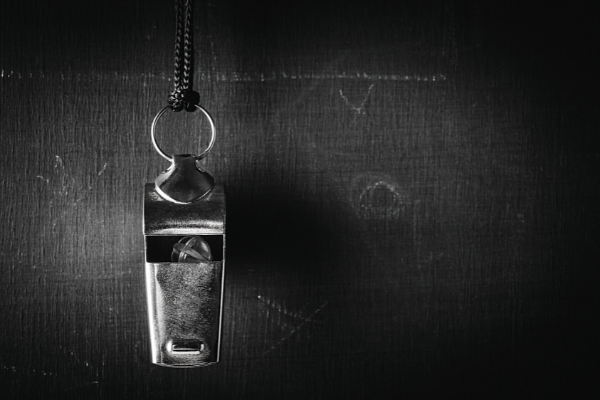Communication, both internally and externally, is core to how your financial brand is perceived by others.
But how do you communicate with courage and confidence in a socially-distant world? That's the key here because courage, just like this virus, is contagious. 
Courage and confidence are keys to helping someone break free from the Circle of Chaos that so many people are stuck in right now. So how can your financial brand communicate courage and confidence when you're not able to see people face-to-face like you might have been before?
The answer is simple. It's video.
Why is video more important now than ever before in this post-COVID-19 world?
Video communication is the primary way to humanize your financial brand's digital experience. And as I've predicted from the very beginning of this crisis, the one that we're all trying to navigate through right now, we would see this pandemic unfold over an 18 to 24 month period. Not necessarily stuck in our homes, but we will be dealing with this crisis psychologically, emotionally, and economically over the next 18-24 months.
As communities are starting to open back up, I do predict that some will get locked back down again if the virus flares back up in the fall and the winter, as many are forecasting. What does that mean? It means we'll be back in a highly remote environment that we were in before. So the time to get comfortable using video to communicate courage and confidence with account holders, team members, along with people in the communities you serve is right now. As I write about in my book, Banking on Digital Growth, digital growth is not about technology. It's about how we use technology to bring two human beings together for good.
Bridging the Digital Experience Gap
I've recommended this type of remote communication strategy for the past few years, not just for financial brand marketing teams, but also for financial brand sales teams. Video bridges the digital experience (DX) and the human experience (HX) with face-to-face communication. Remote video platforms like Zoom, for example, help to further increase an empathetic communication strategy.
93% of communication is nonverbal.
If we break this down even further, out of that 93% of the communication, 55% of that nonverbal communication is body language, and then the other 38% of that communication is vocal tonality. To put it another way, 7% of communication is the actual words that we speak, and having face-to-face communication, even if it is remotely, is strategically important during these times of chaos, confusion, and crisis because people are looking for clarity. They're looking for calm. They're looking for help, and they're looking for hope.
Video communication has become even greater from a societal norm at the macro level because of COVID-19. It's really helping to shape and form new communication habits and new behaviors.
For example, students are using video communication to connect with teachers and peers. I think about how quickly all of my kids were able to get back up and running with school, using video communication. My two oldest, who are still in elementary, have scheduled Zoom calls multiple times a day, while my two youngest are watching YouTube videos that their kindergarten teachers are producing and uploading.
On the healthcare side of things, remote medicine has become the norm, as people don't want to venture out and go to the doctor for fear of catching the virus.
Even fitness and health clubs have moved to remote delivery of classes through online video.
Increase Human Connections
Because of all these shifts in human behavior, video is becoming more normalized, more accepted, and more adopted from a primary channel of communication. I see a tremendous opportunity for financial brands to increase human connections and create exponential value by further deepening human relationships with different audiences.
1. Internal teams that are working remotely: Just because we're opening back up in some cities, in some states, in some countries, doesn't necessarily mean that everyone is going to be flocking back into the office. Jack Dorsey, who's the CEO of Twitter, has been making some news as of recently, as all of his team members can be remote indefinitely. So we're going to see a transformation of work as a result of this crisis. And if we're transforming the way that we work, we must transform the way that we communicate with other team members.2. Consumer account holders who are not able to or don't want to visit a branch location: Once again, just because we're opening back up, doesn't mean everyone wants to come back in and conduct business face-to-face in the drive-thru, let alone the branch. Why? New habits have been formed because of an increase in the adoption of mobile banking. Particularly at an older age demographic, those who were not used to using mobile banking before, have now become accustomed to it over the past few months.
3. Small business owners who have been forced to shut down: They are struggling to survive even as things are opening back up in the communities that we serve. Bonus: Listen to one of the world’s leading chefs share his story about what local resustrants need from financial brands.
How to Implement Video at Your Financial Brand
Here are five practical examples you can use to apply this thinking at your own financial brand, working from the inside out.
1. Conduct daily stand up or huddle meetings
These are typically 15 to 30 minutes, with a small group of team members working remotely. The goal of these daily huddle meetings is to help get out of digital communication like email, and chat, where sometimes things can get lost in translation, while at the same time working to maintain some type of human connection as you want to limit the negative impact of isolation when working remotely.
Now, on the flip side of this, I do understand there are some who are starting to feel Zoom fatigue, and it's very psychologically understandable. But I'm wondering, is it an expectation that we put on ourselves of how we should come into these Zoom conversations, to prepare the space, to be "camera ready?” Or is it just working to transform our behaviors in a new type of communication environment?
Unifying internal teams and keeping morale high by celebrating wins and the progress that we continue to make is the best way to look at kicking off these stand up meetings. At the Digital Growth Institute, we call this WBG, or What's Been Good. Particularly in times of stress and chaos, it's very easy for the mind to go down the dark rabbit hole and get stuck in the cycle of negativity. But when you focus on a positive statement from everyone involved, this should take no more than 30 seconds to a minute per person, it elevates the conversation. It elevates the room, even if that room is remote.
2. Schedule a video meeting secondary call to action on your financial brand's website product pages.Here's why this is important: Even though things are starting to reopen in certain areas around the world, I'm projecting that we'll see some seasonal community lockdowns on and off over the next 18 to 24 months. So take time to bridge the long term DX and the HX, by adding a quick and easy way for them to get in touch with someone at your financial brand that can help guide them remotely, but still face-to-face. This might be for a prospect, a lead, or someone who is interested in making a deposit, or applying for a loan, opening the account. It also might be for a current account holder who has questions about their personal financial situation or needs some additional assistance and guidance with a mobile app.
3. Invite current account holders to schedule a remote video review.This is for those who are looking to get some additional help, some hope even, but they've just not gained the courage to raise their hand yet. There is a psychological toll that financial shame, or money shame, takes on a person's financial health and well-being. Take a proactive stance to do outreach or meet with someone in a judgment-free zone through video and remote communication.
Send out an email to all your account holders letting them know that you're simply there to help, and more importantly that you're merely there to listen to their questions and hear their concerns. Many times that's just what people want. They just want to be heard.
Then, wrap the up email in an empathetic tone of hope, that's framed around your financial brand's position and commitment to confidently provide someone with clarity or with a sense of calm during this time of crisis.
Finally, the primary call to action for this email should be something like, "We are here to guide you through the coming weeks and months. Schedule a remote video review with one of our experts to talk through your unique situation."
4. Conduct video coaching calls with account holders and prospects.Calm the nerves of account holders and work to reduce the fears and anxieties for people in the communities that you serve. There is no better time then now, to consider starting a pilot financial coaching program, as you invite a select number of account holders to register. In return for scheduling one of these financial reviews, they can receive some type of a financial blueprint that has recommendations framed around their unique situation.
5. Connect and build relationships in the communities that you serve, in addition to just your account holders.I recommend hosting weekly or bi-weekly digital town hall or fireside chat-style meetings, where your financial brand will field frequently asked questions that you've received from your call center or through your website, along with sharing stories of hope and optimism based upon the work you are doing to help others. Once again, this type of communication will be delivered through video, but this is not a medium to sell. Instead, it's a medium and a channel to communicate courage and confidence, while also extending help and hope to others.
I see a tremendous opportunity to build a sense of digital community with the physical community your financial brand serves, as you use your own video platform to bring on external guests and to help promote local businesses.
For example, think about a local restaurant owner you can invite to your weekly Facebook Live stream that can talk to your account holders, your Facebook fans, and people in the communities that you serve on how to make a meal each week.
Furthermore, local bartenders can also come on and do some type of a Friday happy half hour, and show your account holders how they can make a weekend craft cocktail.
These examples alone, mixed with your own weekly town hall content, provides so many different ways you could use video to create value four to five days per week.
I'm going to be very, very clear.
It's going to take some time.
It's going to take some planning to pull this off, but with a little practice and some patience, along with committing to progress, not perfection, I'm confident that your financial brand has the potential to use video to communicate with courage and confidence.
This article was originally published on August 21, 2020. All content © 2024 by Digital Growth Institute and may not be reproduced by any means without permission.





